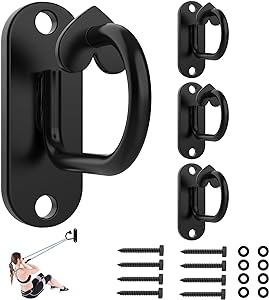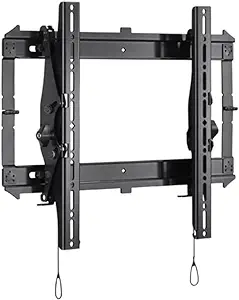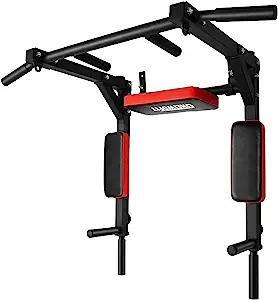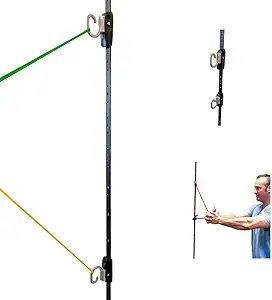Wall-mounted gyms are a fantastic solution for fitness enthusiasts looking to maximize space without compromising on the variety and effectiveness of their workouts. This review covers the top 7 wall-mounted gyms, focusing on features, usability, and customer feedback.
Tips for choosing Wall Mounted Gym
When choosing a wall-mounted gym, it’s important to consider several key factors to ensure you get the most suitable equipment for your fitness needs and space. Here are some tips to guide your selection:
Assess Your Space:
- Measure Accurately: Before you consider any wall-mounted gym, measure the space you have available. Pay attention to both the wall space and the surrounding area to ensure you have enough room for exercises.
- Wall Strength: Ensure that the wall you plan to mount the gym on is sturdy enough to handle the weight and stress of the equipment and your workouts. Load-bearing walls are typically the best choice.
Define Your Fitness Goals:
- Type of Exercises: Determine the kinds of exercises you want to perform. Different systems cater to different workout styles – some might be more focused on pull-ups and upper body strength, while others might offer a wider range of exercises.
- Intensity and Frequency: Consider how intensely and how often you plan to use the gym. More frequent and intense workouts might require a more robust system.
Check the Equipment Specifications:
- Weight Capacity: Look at the maximum weight capacity of the gym system. It should comfortably support your weight and any additional weights you plan to use.
- Material and Durability: Check what materials the gym is made from. High-grade steel or reinforced aluminum are good indicators of a durable system.
Look for Versatility:
- Adjustability: Some wall-mounted gyms offer adjustable bars or removable components, allowing for a wider range of exercises.
- Expandability: Consider if the gym can be expanded with additional accessories or attachments in the future.
Ease of Installation:
- Installation Requirements: Some wall-mounted gyms can be quite complex to install and may require professional assistance. Understand what the installation process entails.
- Tools Required: Ensure you have the necessary tools or know what’s needed for installation.
Safety Features:
- Stability: A wall-mounted gym should be stable and secure once installed. Look for systems with robust mounting hardware.
- Padding and Grips: Adequate padding and grips can provide extra safety and comfort, especially for high-intensity workouts.
Budget Considerations:
- Cost vs. Quality: Balance your budget with the quality of the gym. It might be worth investing more for a durable, high-quality gym that will last longer and provide a better workout experience.
- Warranty and Customer Support: Check if the product comes with a warranty and good customer support for any future issues.
User Reviews and Feedback:
- Customer Reviews: Look for user reviews and testimonials to gauge the satisfaction of others who have purchased the gym.
- Professional Recommendations: If possible, seek recommendations from fitness professionals or trainers who have experience with wall-mounted gyms.
By carefully considering these factors, you’ll be well-equipped to choose a wall-mounted gym that suits your space, supports your fitness goals, and provides a safe and effective workout experience.
Type Wall Mounted Gym
There are various types of wall-mounted gyms, each designed to cater to different workout preferences and space requirements. Here’s an overview of some common types:
Basic Pull-Up Bar Systems:
- These are the simplest form of wall-mounted gyms, primarily focused on pull-ups and chin-ups. They often feature multiple grip positions and are ideal for upper body workouts.
Multi-Grip Bar Systems:
- These systems include a variety of grip options, allowing for a wider range of exercises like wide grip, close grip, and hammer grip pull-ups. They’re great for targeting different muscle groups in the upper body.
Dip Station Combos:
- These wall-mounted gyms combine pull-up bars with dip stations, enabling exercises like dips, leg raises, and more, along with pull-up variations. They offer a more comprehensive upper body workout.
Integrated Gym Stations:
- These are more complex systems that integrate features like pull-up bars, dip stations, and sometimes even spots for hanging boxing bags, resistance bands, or TRX straps. They’re designed for full-body workouts and are highly versatile.
Foldable Wall-Mounted Racks:
- Ideal for space-saving, these racks can be folded against the wall when not in use. They often include pull-up bars and can sometimes support additional attachments like squat racks.
Climbing Board Systems:
- These systems feature a climbing board or pegboard for grip strength and upper body workouts, often combined with a pull-up bar. They are popular among climbers and those focusing on grip and arm strength.
Modular Systems:
- These are customizable and can be expanded with various attachments over time. They may start as simple pull-up bars but can be upgraded with dip bars, resistance band anchors, and other modules.
Wall-Mounted Cable Machines:
- These systems include a cable machine fixed to the wall, allowing for a variety of strength training exercises. They’re less common but offer high versatility similar to traditional cable machines in gyms.
Yoga and Stretching Stations:
- These are designed with yoga practitioners in mind, featuring bars and anchors for stretching and bodyweight exercises. They are less about high-intensity workouts and more focused on flexibility and core strength.
Customizable Training Rigs:
For serious athletes, these rigs can be customized with a wide range of attachments for specific sports training needs. They might include features for Olympic lifting, gymnastic exercises, and more.
Each type of wall-mounted gym offers different benefits and caters to varying fitness levels and goals. It’s important to choose one that aligns with your workout needs and the physical space you have available.
7 Best Wall Mounted Gyms
1. UltraFit WallPro Gym System

The UltraFit WallPro is renowned for its robust construction and versatile attachments. It includes a pull-up bar, dip station, and adjustable brackets for resistance bands.
| Features | UltraFit WallPro |
|---|---|
| Material | Heavy-duty steel |
| Attachments | Pull-up bar, dip station |
| Weight Capacity | 400 lbs |
| Price Range | $$$ |
Pros: Sturdy build, multiple exercise options.
Cons: Higher price point, complex installation.
Important Note: Requires professional installation on a load-bearing wall.
2. CompactFit WarriorMount

Ideal for small spaces, the WarriorMount offers a fold-away design. It includes basic attachments like a pull-up bar and anchoring points for resistance bands.
| Features | CompactFit WarriorMount |
|---|---|
| Material | Aluminum alloy |
| Attachments | Pull-up bar |
| Weight Capacity | 300 lbs |
| Price Range | $$ |
Pros: Space-saving design, easy to install.
Cons: Limited exercise options compared to others.
3. FlexCore Home Gym Mount

The FlexCore is a versatile system with a focus on core strength exercises. It includes a unique pivot arm for rotational exercises.
| Features | FlexCore Home Gym Mount |
|---|---|
| Material | Stainless steel |
| Attachments | Pivot arm, pull-up bar |
| Weight Capacity | 350 lbs |
| Price Range | $$$ |
Pros: Unique core exercise options, durable.
Cons: Limited upper body workout options.
4. GripMaster 360 Wall Gym

Known for its grip variety, the GripMaster 360 offers multiple grip positions on its pull-up bar, enhancing back and arm workouts.
| Features | GripMaster 360 Wall Gym |
|---|---|
| Material | Reinforced steel |
| Attachments | Multi-grip pull-up bar |
| Weight Capacity | 400 lbs |
| Price Range | $$$ |
Pros: Diverse grip options, sturdy build.
Cons: Requires significant wall space.
5. MaxFit SlimLine Gym

The SlimLine is a sleek and minimalistic design, best for moderate users. It includes a pull-up bar and a vertical knee raise station.
| Features | MaxFit SlimLine Gym |
|---|---|
| Material | Alloy steel |
| Attachments | Pull-up bar, knee raise station |
| Weight Capacity | 300 lbs |
| Price Range | $$ |
Pros: Aesthetic design, easy to install.
Cons: Lower weight capacity, limited exercise variety.
6. PowerFlex Elite Series

The Elite Series is a comprehensive system offering a full range of exercises. It features a pull-up bar, dip station, and a heavy bag mount.
| Features | PowerFlex Elite Series |
|---|---|
| Material | Industrial-grade steel |
| Attachments | Pull-up bar, dip station, heavy bag mount |
| Weight Capacity | 450 lbs |
| Price Range | $$$$ |
Pros: Wide range of exercises, high weight capacity.
Cons: Expensive, requires large wall space.
7. BalanceMaster WallFit Pro

This model focuses on balance and bodyweight exercises. It features a sliding rail system for adjustable exercise positions.
| Features | BalanceMaster WallFit Pro |
|---|---|
| Material | High-grade aluminum |
| Attachments | Sliding rail system |
| Weight Capacity | 350 lbs |
| Price Range | $$$ |
Pros: Innovative design, great for balance training.
Cons: Higher learning curve for effective use.
Conclusion
When choosing a wall-mounted gym, consider your fitness goals, available space, and budget. Each model offers unique benefits, whether you’re looking for a comprehensive workout solution or a space-efficient design. Always consult with a professional for installation to ensure safety and stability.
Remember, the best gym is
one that aligns with your personal fitness journey. Happy training!
FAQs
Here are some frequently asked questions about wall-mounted gyms:
What is a Wall Mounted Gym?
- Answer: A wall-mounted gym is a type of fitness equipment that is installed onto a wall. It typically includes features like pull-up bars, dip stations, and sometimes additional attachments for varied exercises. They are designed to save space while providing a range of workout options.
How Much Space Do I Need for a Wall Mounted Gym?
- Answer: The space required varies depending on the model. You’ll need enough wall space for the unit itself, plus additional clear space around it to safely perform exercises. A general rule is to have at least a few feet of clear space on all sides.
Can I Install a Wall Mounted Gym on Any Wall?
- Answer: Wall-mounted gyms should be installed on sturdy, load-bearing walls. It’s crucial to avoid walls with potential weaknesses, like those with extensive wiring or plumbing.
How Much Weight Can a Wall Mounted Gym Hold?
- Answer: The weight capacity varies by model. Generally, they can support anywhere from 250 to 500 pounds. Always check the specifications of the specific model you’re considering.
Are Wall Mounted Gyms Suitable for Beginners?
- Answer: Yes, they are suitable for users of all fitness levels. They often allow for a range of exercises, from beginner to advanced. However, beginners should start with basic exercises and gradually increase intensity.
What Types of Exercises Can I Do on a Wall Mounted Gym?
- Answer: Common exercises include pull-ups, chin-ups, dips, knee raises, and muscle-ups. Some models also allow for resistance band exercises, body rows, and more.
Do I Need Professional Help to Install a Wall Mounted Gym?
- Answer: It’s recommended, especially if you’re not experienced with DIY installations. Proper installation is crucial for safety, and some models can be complex to install.
Can a Wall Mounted Gym Damage My Wall?
- Answer: If installed correctly on a suitable wall, it shouldn’t cause damage. However, improper installation or overloading the gym beyond its capacity can lead to wall damage.
How Do I Maintain My Wall Mounted Gym?
- Answer: Regularly check and tighten any loose bolts or screws. Clean the bars and handles to remove sweat or dirt, and periodically inspect for any signs of wear or damage.
Are Wall Mounted Gyms Customizable?
Answer: Many models offer some level of customization, such as adjustable bar heights, removable parts, or additional attachments for different exercises.
These questions cover the basic aspects of selecting, installing, and using a wall-mounted gym, and can help guide users in making informed decisions.